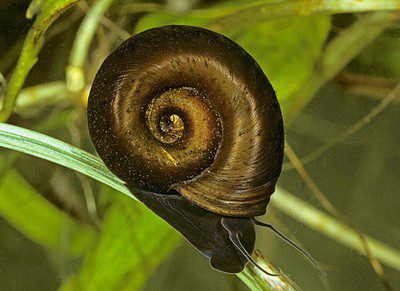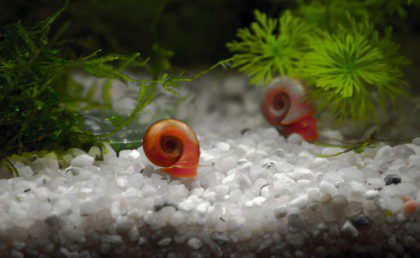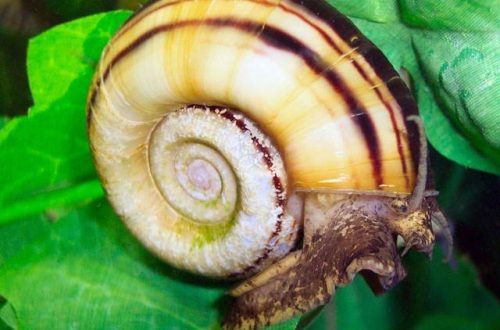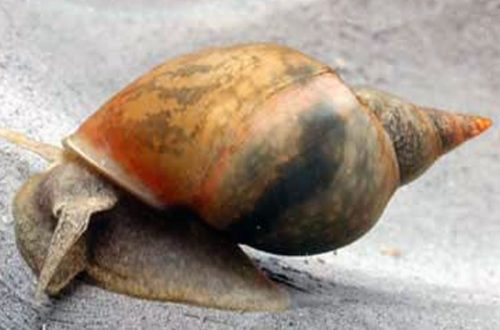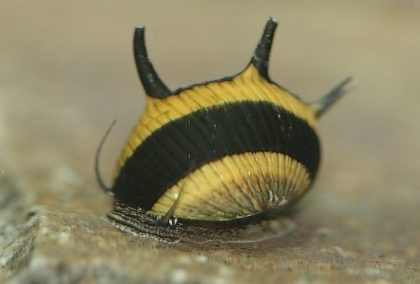
Coil aquarium snail: maintenance, reproduction, compatibility, description, photo

Contents
Description
The snail is a representative of freshwater molluscs. In nature, they live in overgrown ponds with a weak current. It is adapted to survive even in very dirty waters with low oxygen content in the water. This ability is due to the presence of a kind of lungs, allowing her to breathe atmospheric air.
The snail shell resembles a flat, tightly wound spiral. Usually there are four or five turns, with each successive turn becoming thicker. On both sides, the seam between the turns is clearly visible. The mollusk can reach sizes up to 3,5 centimeters in diameter, but most often in an aquarium, coils grow only up to 1 centimeter. By the way, the larger the population of snails, the smaller they will be.
The body color can vary from brown to bright red depending on the type of reel. The mollusk moves with the help of a leg with a wide flat base-sole. Thin long horns are visible on the head.
The snail can also move on the surface of the water, turning its shell down – this ability arises due to the air bubble that is in the shell. In case of danger, she immediately releases this bubble and falls to the bottom. Newborn little snails usually stick together, sticking around aquarium plants.
Reproduction
The coil is a hermaphrodite that can self-fertilize and reproduce further. Therefore, if you want to get a population of these snails, then it will be enough for you to get just a couple of individuals. The snail attaches the laying of eggs to the inside of the leaf of the aquarium plant.
Basically, the population of snails in aquariums is regulated without the intervention of the aquarist, as aquarium fish happily eat young snails. But if the fish are full, then they will not particularly touch small mollusks. If you notice a rapid increase in the snail population, then this indicates that you are overfeeding your fish. Therefore, you just need to cut the rations for the fish and get the snails out of the jar with your hands.
There are cases when aquarists purposefully breed snails, because they go to feed some pets or fish (bots). In this case, it is not necessary to pour soil into the aquarium, as this will complicate the process of cleaning the aquarium. Place several types of floating plants (naiad, pistia, riccia, java moss) in the jar. If you could not find any, plant wallisneria, Canadian elodea or hornwort. Snails can be fed dry fish food and scalded cabbage, lettuce and spinach leaves.
Reel in the aquarium
Planorbis snails get into the home pond in different ways, but more often the appearance of a mollusk among aquarium inhabitants is a real surprise for the owner. Now he only has to regulate the population of mollusks in the reservoir and ensure the comfort of their coexistence with its other inhabitants. Snails are unpretentious creatures that do not require special care:
- being tolerant of a wide range of temperatures, snails are quite satisfied with the temperature regime of water that is created for tropical fish, that is, within 22-28 ° C;
- there is no need for special feeding of mollusks, since they are content with the remains of food of other underwater inhabitants, a green coating on the glass of the reservoir, and rotted fragments of tank plantings (mollusk juveniles, as a rule, in a colony keep precisely on a rotten leaf of a plant).

The possibility of such a method of movement is determined by the presence of air in it, let in by the snail itself. In this case, an additional support for the mollusk is a film on the surface of the aquarium water, formed by the waste products of bacteria or the own force of the surface tension of the water.
If there is any danger, releasing air from the shell, the coil headlong sinks to the bottom, so as not to be eaten by predatory fish. This action is performed by the snail at the level of a reflex for the purpose of self-preservation.
The fact is that the mollusk is a favorite dish for certain types of aquarium fish, which easily bite through its saving shell. In some cases, the owners of home aquarium tanks, with an excessive growth of the mollusk population, specially plant such types of fighter fish in the reservoir so that they thin out the rows of snails, balancing their number.
Types
- Coil Horn. In nature, it lives in stagnant water bodies with dense thickets of plants. The color of the shell is brown, the dimensions are up to 3,5 centimeters. The body is colored reddish-brown, in tone with the shell. The horn coil prefers to feed on the remains of food and plants from the bottom of the aquarium.
- Coil Horn Red. The size of this snail is smaller, up to 2 centimeters. It also differs from the usual horn coil in the bright red color of the shell. The benefit of the red horn coil is that it is an excellent aquarium cleaner. From a decorative point of view, this species is the most advantageous – their fiery color looks great against the background of greenery.
- Coil Far East. The Far East coil came to us from the reservoirs of East Asia. Just like her relatives, she is unpretentious. The shell color is red-brown, the number of whorls is from five to six. The diameter is small – only 1 centimeter. The Far East coil feeds on plants.

- Keeled coil. This is the most frequent visitor in aquariums. It gets into them with plants or soil. Color is greyish brown. The main feature of the keeled coil is that the diameter of the shell is much larger than the width: at 6-7 turns and a diameter of 2 centimeters, it has a width of only 4 millimeters. This snail collects food at the bottom, and also enjoys eating algae, cleaning the aquarium walls.
- Coil Wrapped. This type of coil is called a pest: it multiplies extremely actively, filling the entire aquarium in the shortest possible time and harming both the appearance and the condition of water and soil. It reaches sizes up to 1 centimeter. The color of the shell is dirty yellow, the shell is not very strong.
Than useful
Although most often snails appear in the aquarium by accident, some aquarists deliberately leave them, believing that the benefits outweigh the harm.
The decorative function of these snails is indisputable. Coils are pretty cute aquarium ornaments. They are fun to watch and their presence in a fish tank creates a more natural look.
It happens that coils, like other snails, are called aquarium orderlies. This is partly true. Coil snails eat rotten leaves of algae, while not touching healthy ones. They collect the remains of fallen food, thereby ridding the aquarium of debris. Also, the coils are able to remove the film from the surface of the water and clean the aquarium walls.
Snails become an indicator of water pollution, suggesting that it is time to clean up or reduce the amount of food for fish. If the population of coils has grown significantly, this is the signal.
Some aquarists breed coils in their aquariums as fish food. Many fish are happy to feast on mollusks, and the fecundity of this species makes it easy to maintain numbers.
What are harmful
Despite the fact that the benefits of snails are quite large, many people prefer to get rid of mollusks as soon as they find an intruder.
Coils are very prolific. They are hermaphrodites, and only a couple of snails are enough to get a whole flock of mollusks. Rapid reproduction leads to an increase in the amount of their waste products, which harm and pollute the aquarium.
If the snails do not have enough food, they will take up aquarium plants. And not for rotten leaves, but for healthy ones. Gluttonous coils will quickly destroy the plant.
The snail-coil can cause fish illness. Often this happens when the snail was brought into aquarium conditions from a local reservoir. In such a situation, the fish will have to be treated with special preparations that the snails most likely will not tolerate.
In general, an overgrown flock of snails spoils the appearance of the aquarium, hanging in clusters on the walls and plants.
DO COILS CARRY PARASITES?
Reels are known to be carriers of parasites during their lifetime that infect and even kill fish. But this is in nature, and in an aquarium the chance of transferring parasites with snails is much lower than with food. Even in frozen food, not to mention live food, various parasites and pathogens can survive.
So I wouldn’t worry about it. If it is very important for you to have snails, but you are afraid to bring parasites, then you can bring roe of coils into the aquarium, which is not a carrier.
Truths and myths about coils
Very often, articles about snail coils contain a lot of conflicting information, including negative ones.
Coils multiply uncontrollably. Indeed, a mollusk population can grow rapidly, but only if they have no natural enemies in the aquarium or the fish are constantly fed. And this can be corrected.
Planorbis spoils the green spaces of domestic ponds. Actually it is not. The mollusk is often seen on a rotten plant, and in fact he is in this place because he eats this very decomposed part of the plant. A snail is unable to make a hole in a healthy leaf, since it has naturally weak teeth.
Coil snails carry parasites which infect aquarium fish, and sometimes destroy them. Hypothetically, this is possible, but it is much more likely to introduce parasites with food (especially live food from the nearest reservoir). Therefore, you just need to take safe coils in a specialized store.
In conclusion, I would like to note the following in defense of snails: whether or not to keep coils in a home aquarium, everyone decides for himself, but the benefits of these orderly molluscs are obvious, and all the inconveniences associated with them can be minimized.



